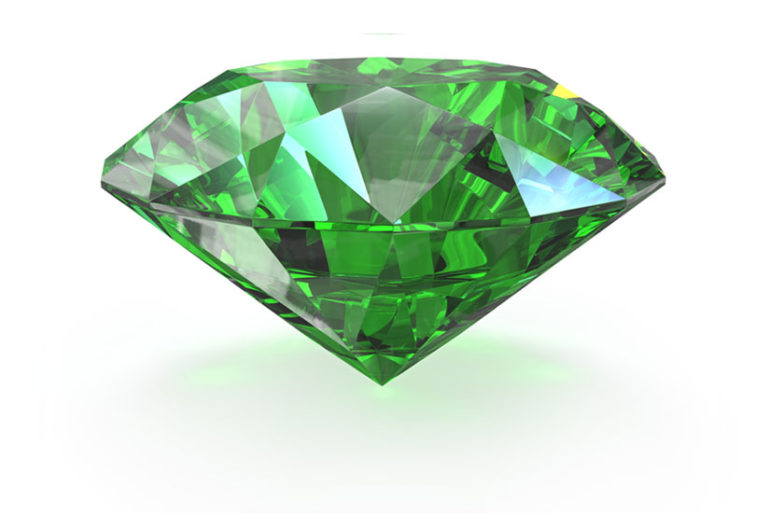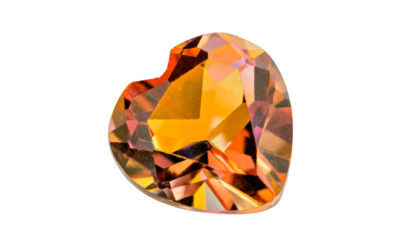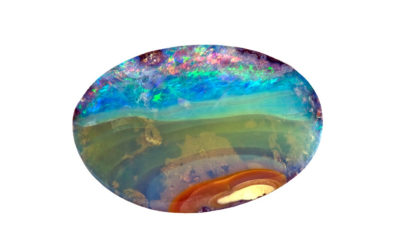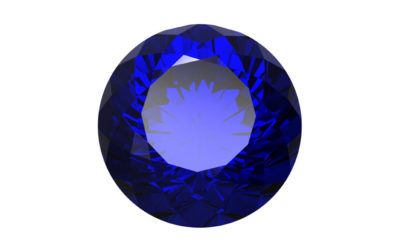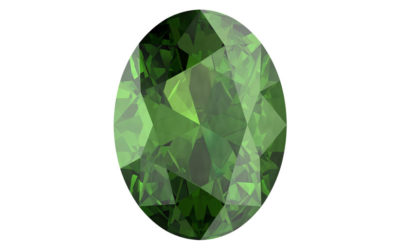In 1939, Dorothy clutched her dog, Toto, by her side and said that they weren’t in Kansas anymore. Dorothy and company followed the yellow brick road and eventually reached the striking Emerald City. Reaching for the sky in illustrious pillars of green, they’ve finally come to their journey’s end. What happened after that has been called one of the best movies of all time. Brimming with color, The Wizard of Oz was considered an instant masterpiece and bewildering to people who had never seen color on the silver screen.
It’s hard not to hold a piece of the May birthstone in your hand and not think of how brilliant the gem is. Rather if we’ve seen it on the silver screen or held it in person, it’s hard not to fall in love with an emerald gem.
The emerald is a precious gem
The emerald is similar to its diamond brethren and is a precious gemstone. It comes from the mineral class known as beryl. It is commonly seen as a deep shade of green, but that’s not the only color that it comes in. Having a hardness of 7 to 8 on the Mohs scale, the gem is sturdy enough to make jewelry but the resistance to cracking is on the lower side.
Gem experts grade the gem by using for different description types: their color, cut, clarity, and carat weight. What makes the four measuring factors different for emeralds in comparison to other gems is that their clarity isn’t as much of a priority when it’s being graded. In general, they tend to have a deeper and at times clouded look to their coloration.
Some emeralds are not considered “emeralds”
Not all pieces of green beryl were treated equally. Back in the 60s, the green vanadium type beryl was not defined as an emerald. That has changed, but only here in America. If you take a piece of vanadium emerald into the UK or Europe, your gem won’t be recognized as a regular emerald. The distinction has come to be known as a “Colombian emerald” (Colombian Emerald).
Emeralds have been around for a while
Some sources say that it was sold in the Babylonian markets near the 4,000 BC mark. The Incas had apparently worshipped the stone because the lore mentioned that Chaldeans believed that the gem has a goddess in it. This gave it a highly revered status among its people. In ancient Egypt, the gem was associated with Thoth, the god of wisdom. Therefore, it was considered a favorite of Queen Cleopatra.
Where are they found?
The gem was mined even in ancient times. It was found in Mount Smaragdus dating back to 1500 BCE. Records show that the gem appeared in Austria and India beginning around the 14th century CE. The Roman and Byzantine Empires had even used the Egyptian mines. Islamic influences did after that as well. The Colombian deposits changed that, and the areas are now mostly ignored.
To this day, Colombia is the focal point of most of the emerald mining and trade. Estimates show that it takes up about 50% to 95%. Early 2000 saw a surprising increase with that percentage becoming 78!
Colombia has three main mines – Chivor, Coscuez, and Muzo. It is also the country you’ll find the highly sought after “trapiche emeralds,” which are quite rare.
The second largest place that produces the gem is Zambia. More specifically, you’ll find them in the Kafubu River deposits and in the southwest area not too far from Kitwe. It is reported that Kagem Mines made up over three tons of the world’s emeralds during 2011. That’s quite impressive!
The gem is found elsewhere in the world. You can find them in: Zimbabwe, Tanzania, Switzerland, Spain, South Africa, Somalia, Russia, Pakistan, Norway, Nigeria, Namibia, Mozambique, Madagascar, Kazakhstan, Italy, India, Germany, France, Ethiopia, Egypt, China, Canada, Cambodia, Brazil, Bulgaria, Afghanistan, Australia, and Austria. (Try saying all those under one breath!) They’ve also been found in parts of the US, specifically in South and North Carolina, Connecticut, Nevada, and Montana.
May and part of June and July share the emerald
Not only is the gem a representative of the month of May but also considered to be the gemstone for the astrology sign Cancer.
Cancers are those who are born between June 25 and July 25. Known for being moody, sensitive, and nurturing, the water sign may give us some interesting insights into how we’ve come to associate the color green with security. Much like Cancers, it can be argued that we all thrive for a sense of security. Without it, we feel vulnerable and we’re full of anxiety. Green is highly associated with money and wealth, which unfortunately what makes many of us feel secure.
Going back to Emerald City from the Wizard of Oz, some scholars believe that the literary representation of green in the fictional city was meant to represent wealth and prosperity. Dorothy and company followed the Yellow Brick Road to their final destination.
In the books, the citizens have to wear green glasses. They’re meant to block the eyes from being overwhelmed by the “brightness and glory” of the city. Some American scholars have modernized this narrative to be a representation of prosperity in America. The emerald green of the city was meant to represent the prosperity of the nation and the city itself, Washington DC, where the seat of power is.
The emerald and the Bible
Little bits of the gem are found in stories from Brantome, a sixteenth-century historian. He was enthralled by the emeralds that some of Cortez’s men brought back from their journey to Latin America. On one piece of the May birthstone, he had engraved (translated) “Among those born of women there hath not arisen a greater.” The quote comes from the Bible, more specifically the Book of Matthew 11:11. The reference extends to John the Baptist.
Emeralds need to be treated due to their fragility
It’s very common for emeralds to be treated. Prior to being bought, they’re treated with epoxy resin and oil which help to fill any cracks that may be on the surface. This makes the cracks harder to see and makes the gem more transparent. While some oils used on the gem are clear, some are tinted green to help give the gem that extra depth of color (Understanding Emerald).
This makes cleaning jewelry with it rather difficult. If you are to clean it, it is best to use a very mild soap. You’ll want to avoid ultra-sonic cleaning because it will damage the coating.
Synthetic emeralds also exist
Not everyone can afford the precious gem that’s why it’s great to know that emeralds can and have been artificially produced in labs. Not only are they helpful for those on a budget, but they also look like the real thing.
They represent the heart and intuition
The gem stimulates the heart chakra and therefore, brings about positive physical health to the heart. It balances the three spheres of your life – emotional, spiritual, and physical. Because the heart is considered the center of one’s body by some cultures, balancing the heart means you’re balancing these three attributes as well.
Speaking of the heart, the gem also helps to bring stronger tethers to your romantic relationships. It’s considered to help concentrate your passions toward that one special person. It makes sense when you think about May being a month of spring.
The gem, according to spirit healers, helps to invigorate your intuition. In other words, it helps the wearer to make spot-on decisions and fairer judgments. Its symbolism of healing makes it a perfect piece of jewelry for those in the hospital career fields. Nurses, paramedics, doctors, therapists – they’d all be perfect candidates to don emerald jewelry.
More than one shade of green
The gem comes in variants of green shade. The color wholly depends on how it was cut. Known as the “emerald cut,” this very specific style of cutting has become iconic in the jewelry world. Gemologists who have good hands can manipulate the shade that the gem attracts by facets and cuts to bring about minimum or maximum light exposure.
Well-loved by famous people from the past
Iconic people from history’s past have been known to wear emeralds. One ruler, Cleopatra, apparently had a soft spot for the gem. A legend says that she had even taken ownership of the mines of Egypt just to make sure she got the best cuts.
Elsewhere in the world, the gem is found in the British Crown as well. The late and fabulous Elizabeth Taylor also was known to love the gem. It’s reported that her pendant with the gem on it sold for six and a half million dollars!
It was once said by lithologist St. Hildegard that, “All the green of nature is concentrated within the emerald.” The gem harvesting the green of the world sounds so poetic. It’s as if, from beneath the earth, the rock sits silently and brings forth the greenness and richness of the grass and trees toward it. But instead of being a leech, it reflects an earth color, the symbol of life. It’s hard not to imagine a perfect pasture. It’s green for acres and there’s a wind that rustles the verdant leaves of the nearby trees. Maybe that’s what St. Hildegard meant.
Emeralds are the eyes, heart, and love
Because the gem is centered on the heart, the gem is known for having a soothing aura about it. It brings newness and revitalizes the spirit. It’s been known to create a sense of inspiration and brings about a fountain of patience to the wearer.
It’s also associated with unconditional love, unity, and compassion. Its partnerships aren’t just romantic though as it can also help to tether together strong friendships. The gem was even known to be dedicated to the goddess of love, Venus herself. It brought about love and security.
The May birthstone is also associated with our sight and eyes. Wearing the stone brings with it enhanced vision and a stronger intuitive nature. The sight element also is associated with inward sight, so it was able to tell the future and even reveal the hidden truth within someone.
As a stone of wisdom, it also helped to bring forth strong memory and a clearer state of mind. This made it ideal for those who were trying to get over a psychological trauma–by bringing forth what was once hidden. The gem was also used to protect the wearer against spells and enchantments.
Emeralds, Esmeralda, and Oz … (Oh My!)
The emerald, as we know it today, also has interesting lore behind the word itself. It is believed to have been first translated from Sanskrit as marakata, which means, “the green of growing things.” Our term is believed to come from an ancient Persian word that was then translated to the Greek word, smaragdus. Its meaning is “greenstone” (Smaragdus).
Other words that have been closely associated with the gem are Esmeraulde, Esmaraldus, and Esmaralda. These all may seem close to a name many Disney fans have come across if they’ve watched the company’s rendition of The Hunchback of Notre Dame.
In the film, a character named Esmeralda has piercing green eyes. She’s considered exotic and an outcast. While this association may make her seem bad, we all know that in Disney films, it’s usually the underdog who wins the day! And therefore, we sympathize with her plight and are pleased when she gets a happy ending.
—
The May birthstone has fascinated us for centuries for its color, value, and symbolism. The film classics The Wizard of Oz and The Hunchback of Notre Dame have continued to reinforce the emerald’s value in subtle ways. Emeralds remind us of the vibrancy of life.
References
Four Mine. “Colombian Emeralds | Emerald Education” FourMine.com, www.fourmine.com/education/gemstone-education/emerald-gemstone/colombian-emeralds (accessed October 3, 2018)
International Gem Society. “Understanding Emerald Enhancements and Treatments – Gem Society” GemSociety.org, www.gemsociety.org/article/emerald-enhancement/ (accessed October 3, 2018)
Glosbe. “Smaragdus – Latin-English Dictionary – Glosbe” Glosbe.com, glosbe.com/la/en/smaragdus (accessed October 3, 2018)

